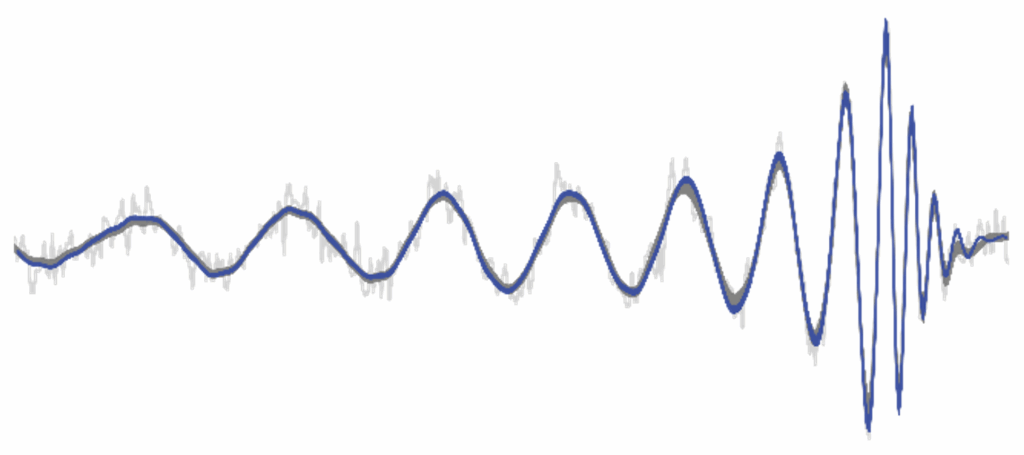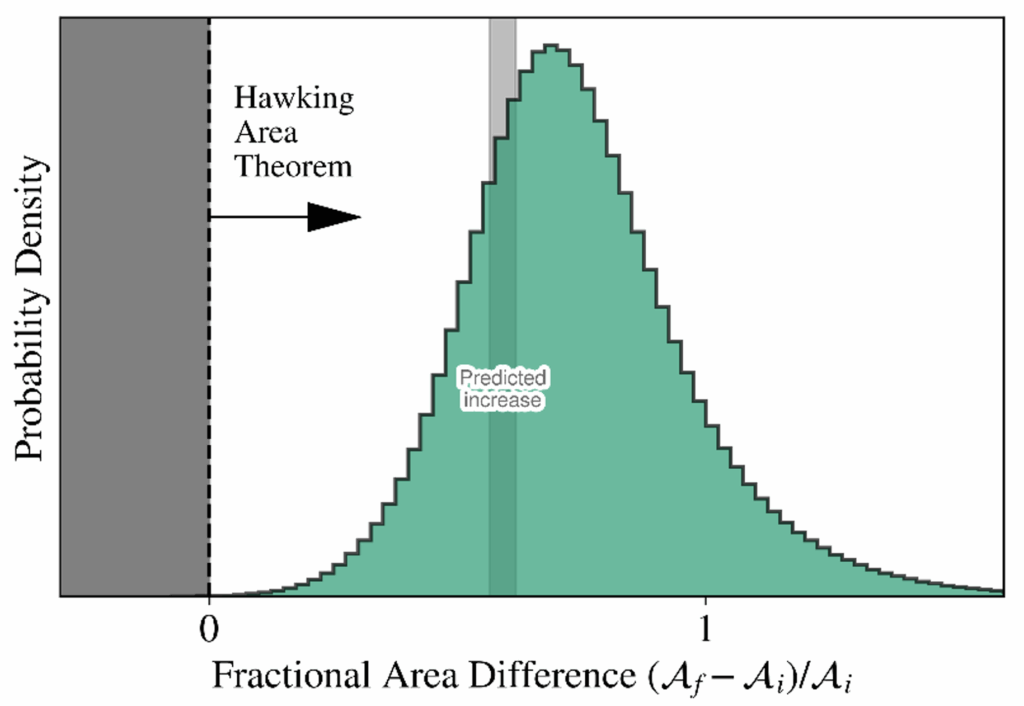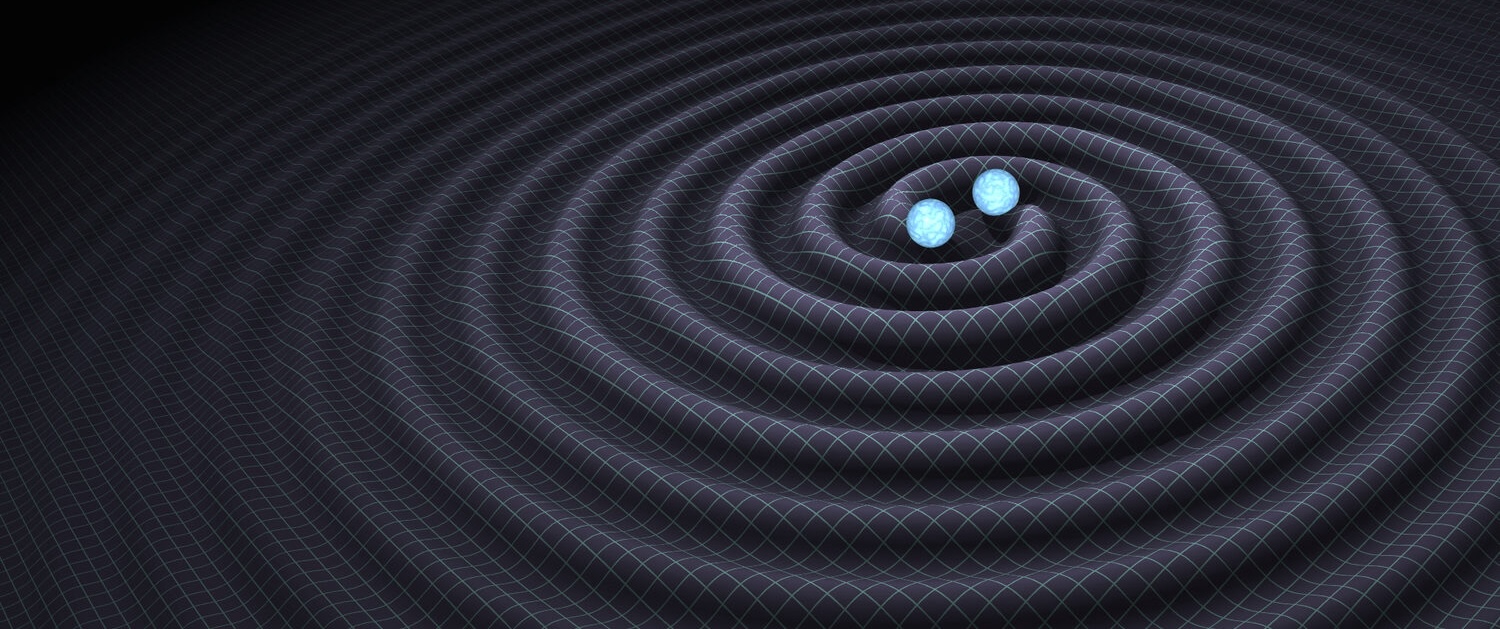On the 10th anniversary of the detection of gravitational waves, the LIGO, Virgo and KAGRA (LVK) collaborations report a new signal from merging black holes: GW250114. The black holes were strikingly similar (in their masses and distance) to those observed in LIGO’s first detection, in 2015: GW150914. But, after 10 years of improvements to both the gravitational-wave detectors and the methods used to analyse their data, LVK researchers were able to “hear” GW250114 three times as clearly (see Figure 1) as that pioneering first detection. With this unprecedented observation, LVK researchers have confirmed that black holes only ever grow in size and that, when disturbed, they ring like a bell with the “sound” predicted by Einstein.

Figure 1: (Adapted from Figure 1 of our publication.) The gravitational wave event GW250114 observed by the LIGO Hanford (left panel) and LIGO Livingston (right panel) detectors. The two plots show how the gravitational wave strain produced by the event in each LIGO detector varied as a function of time (in seconds) and frequency (in hertz, or number of wave cycles per second). Both plots show the frequency of GW250114 sweeping sharply upwards, in a chirp-like pattern, from roughly 30 Hz to 250 Hz over two tenths of a second.
Over 50 years ago, Stephen Hawking and Jacob Bekenstein conjectured that the area of a black hole’s event horizon encodes its entropy. Entropy is a measure of the disorder, or chaos1, of a system that can only increase over time, as has been known since the time of steam engines. If their conjecture holds, this means black hole areas can only grow. This fascinated physicists because according to Einstein’s theory of gravity, General Relativity, black holes should be extremely simple objects that are only described by two numbers2: their mass and spin. Yet Hawking’s and Bekenstein’s findings suggest black holes are simultaneously simple while encoding massive amounts of chaos. This duality underlies a deep connection between space-time and quantum mechanics.
GW250114 tests both of these unique facets of black holes: that they are simple objects and that their entropy always increases. The clarity and strength of the signal from GW250114 enables the most precise characterization of black hole “ringing” yet.

Figure 2: Schematic illustrating the very good agreement between the data (shown in light grey) observed by the LIGO Livingston detector at the time of the GW250114 detection and our best model for the gravitational waves produced by the collision of the two black holes (shown in dark blue). Also included is the dark grey band which shows a reconstruction of the waveform without assuming the signal was produced by two black holes. The fact that the dark grey band is consistent with the dark blue band indicates that our model is accurately describing the signal.
When a spinning black hole is perturbed (as will occur when it is born during a merger of two parent black holes) it vibrates like a bell or a drum, emitting a unique gravitational “sound” that quickly fades away. Its ringing is hypothesized to behave like that of the mathematical idealization first predicted by Roy Kerr, which is a black hole that rotates — known colloquially as a Kerr black hole. To test this hypothesis, LVK researchers used the GW250114 signal to carefully isolate the “sound” of the black hole resulting from the collision (i.e., its gravitational wave emission) and were able to determine that it matched the “sounds” of a Kerr black hole.
To understand the ringing of a black hole, imagine musical instruments. Each instrument has a unique sound that is determined by its shape and material properties — a bell sounds differently than a drum or a guitar. But the sound also depends on how the instrument is perturbed: hitting a drum with a stick produces a different sound than hitting it with a brush. Kerr black holes can only emit sounds of certain frequencies and durations, uniquely determined by their mass and rotational speed. A perturbation causes some, but usually not all, of those sounds to be emitted. If more than one of them is measured, they can be compared to each other: do they correspond to the same Kerr black hole? LVK Researchers were able to determine with high confidence for the first time that at least two of the predicted black hole sounds were emitted by the final black hole and their frequencies were in agreement with the expectations for a Kerr black hole. The remnant of GW250114 is indeed a simple black hole described only by its mass and spin.
At the same time, LVK researchers confirmed that the area of that remnant black hole is larger than the sum of the areas of the two initial black holes (see Figure 3). The ringing of the final black hole carries all the information needed to measure its area. The initial black holes, though they do not ring, still emit their own gravitational signal too. As they orbit around each other, they lose energy to gravitational waves and “fall” toward each other. LVK Researchers used the GW250114 signal from before the black holes had collided to measure the areas of the initial black holes. These completely independent measurements confirmed that the GW250114 merger had indeed increased the entropy of the Universe!

Figure 3: (Adapted from Figure 5 of our publication.) Probability distribution for the fractional area difference of GW250114, equal to the area \mathcal{A}_f of the final black hole minus the sum of the areas \mathcal{A}_i of the initial black holes, divided by \mathcal{A}_i as a normalization. Hence, according to the Hawking Area Theorem, the fractional area difference should lie to the right of the dark gray shaded region – i.e., to the right of the dashed vertical line that corresponds to a fractional area difference of zero, when \mathcal{A}_f = \mathcal{A}_i. We can see that the probability distribution strongly disfavors values of the fractional area difference which are less than zero; this is consistent with the Hawking Area Theorem. The peak of the probability distribution is also in good agreement with the light gray vertical band, labelled “Predicted increase”, which indicates the fractional area difference predicted by General Relativity, corresponding to an increase in area of about 65%.
The detection of GW250114 was made possible by the decades-long work of thousands of scientists to improve gravitational-wave detectors, understand how black holes should ring, and devise ingenious ways to “hear” that ringing from the data. On its tenth birthday, gravitational-wave science is thriving and continues to offer a completely new way to explore our universe – with likely many more surprises to come.
Find out more:
- Visit our websites:
- Read the article at the journal, Physical Review Letters here.
- Read a free preprint of the full scientific article here.
- Gravitational-Wave Open Science Centre data release for GW250114 available here.
1 Strictly speaking, in mathematics chaos refers to another concept distinct from the notion of disorder, but the terms are often used interchangeably in informal descriptions — see, e.g., here.
2 Technically black holes can also have a net electric charge, but black holes formed from stars are expected to have negligible net electric charge.
Back to the overview of science summaries.

